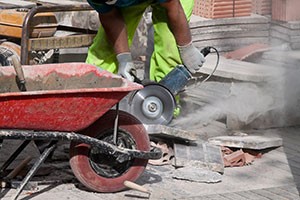Using Stonecutters and Splitters? Helpful Guidelines to Maintain Safety

Provide employees using stonecutters and splitters with the knowledge, training, and equipment needed to reduce the risk of serious injuries on the job.
The Occupational Safety and Health Administration (OSHA) suggests asking questions to help identify hazards involved with stonecutters and splitters used by work crews. Some helpful questions to ask include:
- Has the safety of the machinery been evaluated?
- Will any worker body parts be close to the cutting blades when the machine is being operated?
- Does the material itself pose a hazard as it is being processed, such as flying rock chips or dust?
- Does the machine have guarding and, if so, is the guarding easily bypassed or removed?
- Does the guarding keep workers’ body parts out of the danger zone?
Based on answers to these questions, OSHA recommends the following for employees using stone-cutting and splitting machines:
- Equip stonecutters with machine guarding that protects workers’ limbs from moving machine parts or “points of operation,” the areas on the equipment where the material is processed, such as cutting blades. Some machine-guarding devices include barrier guards, remote operator controls, two-handed starting devices, and electronic safety controls
- Regularly inspect, clean, and maintain equipment according to the manufacturer’s recommendations. Proper equipment maintenance plays a critical role in worker safety
- Provide personal protective equipment (PPE) to protect workers from identified hazards. To reduce injuries from flying particles or rock chips, employers can provide work crews with safety glasses or head and face protection. Work gloves can protect hands from cuts and abrasions when handling stone or rock. Hearing protection should be used to protect workers’ ears from noise hazards when using loud machinery and respirators must be worn to prevent silica-related lung disease
- Train workers to understand hazards involved in using stone cutters and splitters, to properly operate the machines, the purpose and appropriate use of machine-guarding, how to report problems and unsafe conditions, and the correct use of PPE
- Provide supervision to ensure only trained workers use stone cutting and splitting equipment, prevent other workers from being near the machine during cutting, and ensure employees do not wear jewelry, loose-fitting clothes, or other items that could become entangled while operating cutters or splitters
- Install and maintain engineering controls to eliminate or reduce the amount of silica in the air and the build-up of dust on equipment and surfaces: exhaust ventilation, dust collection systems, water sprays, and enclosed cabs


